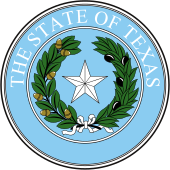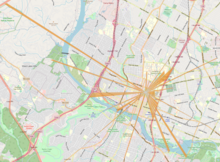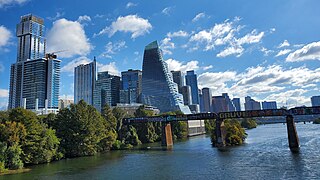
Austin is the capital city of the U.S. state of Texas, as well as the seat and most populous city of Travis County, with portions extending into Hays and Williamson counties. Incorporated on December 27, 1839, it is the 10th most populous city in the United States, the fourth most populous city in Texas, and the second most populous state capital city. It has been one of the fastest growing large cities in the United States since 2010. Downtown Austin and Downtown San Antonio are approximately 80 miles (129 km) apart, and both fall along the Interstate 35 corridor. This combined metropolitan region of San Antonio–Austin has approximately 5 million people. Austin is the southernmost state capital in the contiguous United States and is considered a Beta-level global city as categorized by the Globalization and World Cities Research Network.

The Texas State Capitol is the capitol and seat of government of the American state of Texas. Located in downtown Austin, Texas, the structure houses the offices and chambers of the Texas Legislature and of the Governor of Texas. Designed in 1881 by architect Elijah E. Myers, it was constructed from 1882 to 1888 under the direction of civil engineer Reuben Lindsay Walker. A $75 million underground extension was completed in 1993. The building was added to the National Register of Historic Places in 1970 and recognized as a National Historic Landmark in 1986.

The Lyndon Baines Johnson Library and Museum, also known as the LBJ Presidential Library, is the presidential library and museum of Lyndon Baines Johnson, the 36th president of the United States (1963–1969). It is located on the grounds of the University of Texas at Austin, and is one of 13 presidential libraries administered by the National Archives and Records Administration. The LBJ Library houses 45 million pages of historical documents, including the papers of President Johnson and those of his close associates and others.

A protected view or protected vista is the legal requirement within urban planning to preserve the view of a specific place or historic building from another location. The effect of a protected view is to limit the height of new buildings within or adjacent to the sightline between the two places so as to preserve the ability to see the landmark as a focus of the view. The protection may also cover the area behind the place or building concerned.

Loop 1 is a freeway which provides access to the west side of Austin in the U.S. state of Texas. It is named Mopac Expressway after the Missouri Pacific Railroad. Local residents almost always use the name "MoPac" rather than calling the road by its number, which can cause much confusion, for few signs along the road use this name.
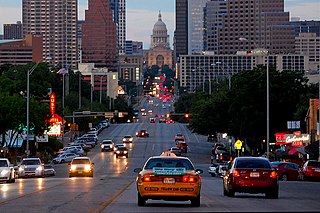
Congress Avenue is a major thoroughfare in Austin, Texas. The street is a six-lane, tree lined avenue that cuts through the middle of the city from far south Austin and goes over Lady Bird Lake leading to the Texas State Capitol in the heart of Downtown.

Capital MetroRail is a hybrid rail system that serves the Greater Austin area in Texas and is owned by Capital Metro, Austin's primary public transportation provider. The Red Line is Capital Metro's first and currently only rail line, and connects Downtown Austin with Austin's northwestern suburbs. The line operates on 32 miles (51 km) of existing freight tracks, and serves nine stations. After a series of delays, Capital MetroRail was inaugurated in March 2010. Capital Metro added Friday evening and Saturday afternoon and evening regularly scheduled service on March 23, 2012. In 2022, the line had a ridership of 466,800, or about 1,500 per weekday as of the third quarter of 2023.

The Lee and Joe Jamail Texas Swimming Center is an aquatics facility at the University of Texas at Austin in the USA. It is home to the university's swimming and diving teams, a variety of university-offered swimming and scuba-diving classes, as well as Longhorn Aquatics, a youth program. The facility also hosts the annual State high school championships in swimming and diving, run by the University Interscholastic League.

Oakwood Cemetery, originally called City Cemetery, is the oldest city-owned cemetery in Austin, Texas. Situated on a hill just east of I-35 that overlooks downtown Austin, just north of the Swedish Hill Historic District and south of Disch-Falk Field, the once-isolated site is now in the center of the city.

The French Legation is a historic legation building in eastern Austin, Texas, built in 1841 to represent the French government in the new Republic of Texas.

Wooldridge Park, also known as Wooldridge Square, is an urban park in downtown Austin, Texas. The park consists of a city block containing a natural basin whose sides slope inward to form an amphitheater with a bandstand at its center. The park was added to the National Register of Historic Places in 1979.
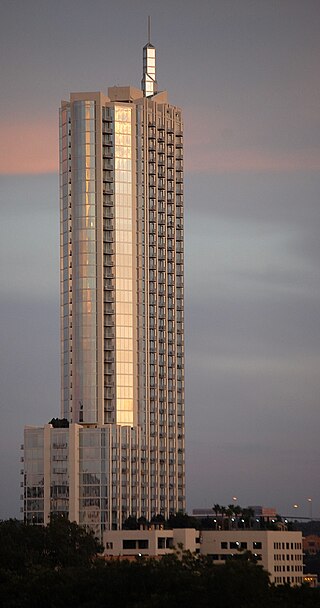
The 360 Residential Condominiums skyscraper is located in Downtown Austin, Texas at 360 Nueces Street. The building itself stands 581 ft (177 m) tall with 44 floors, 430 condos, and over 14,000 sq ft (1,300 m2) of retail space. The building topped out in November 2007, and construction was officially completed on May 22, 2008. 360 Condominiums was the tallest building in Austin from January 15, 2008 to June 29, 2009 when The Austonian surpassed it. The tower also became the tallest residential tower in Texas, surpassing The Merc in Dallas before the Austonian also took that title. Currently, it is the fourth tallest building in Austin after The Independent, The Austonian, and the Fairmont Austin.

Downtown Austin is the central business district of Austin, Texas, United States. The area of the district is bound by Lamar Boulevard to the west, Martin Luther King Jr. Boulevard to the north, Interstate 35 to the east, and Lady Bird Lake to the south.

Robert Mueller Municipal Airport(IATA: AUS, ICAO: KAUS, FAA LID: AUS) was the first civilian airport built in Austin, Texas, United States. It was located a few miles northeast of downtown Austin. It was replaced as Greater Austin's main airport by the Austin–Bergstrom International Airport, which is located on the site of the former Bergstrom Air Force Base. The airport was named after Robert Mueller, a city commissioner who died in office in January 1927. Robert Mueller Municipal Airport was identified with the airport code AUS, which was reassigned to Austin–Bergstrom International Airport in 1999.
East Riverside-Oltorf is a neighborhood in Austin, Texas, located southeast of the city's urban core. The East Riverside, Parker Lane, and Pleasant Valley neighborhoods together form the East Riverside-Oltorf Combined Neighborhood Planning Area. The region is bounded on the north by Lake Lady Bird, to the east by Grove Boulevard and the Montopolis neighborhood, Texas State Highway 71 to the south, and Interstate 35 and South River City to the west.

Society for the Preservation of Downtown Los Angeles, also known as SP-DTLA, is a 501(c)(3) organization that advocates what it characterizes as responsible and respectful development around and among Downtown Los Angeles' historic structures. SP-DTLA supports development with a positive impact on the designated Los Angeles Historic-Cultural Monuments in Downtown Los Angeles, especially those in the Historic Core.

The Westgate Tower is a mixed-use high-rise building in downtown Austin, Texas. The twenty-six-story 261-foot (80 m) tower block was designed in 1962 and completed in 1966; its name reflects its location across the street from the west gate of the Texas State Capitol. Designed by architect Edward Durell Stone, the tower was added to the National Register of Historic Places in 2010 and designated a Recorded Texas Historic Landmark in 2012.

Gregorio Eduardo Casar is an American politician who is the member for Texas's 35th congressional district in the United States Congress since 2023. He served as a member of the Austin City Council from the 4th district from 2015 to 2022. Casar is a member of the Democratic Party and was endorsed by the Working Families Party in his run for Congress. Casar is an unendorsed member of the Democratic Socialists of America. He was first elected to the Austin City Council in 2014, and reelected in 2016 and 2020. He was elected to Congress in 2022.

The 1928 Austin city plan was commissioned in 1927 by the City Council of Austin, Texas. It was developed by consulting firm Koch & Fowler, which presented the final proposal early the next year. The major recommendations of this city plan related to Austin's street plan, its zoning code, and the development of major industries and civic features, but it is most remembered for institutionalizing housing segregation by designating East Austin as the city's negro district.
